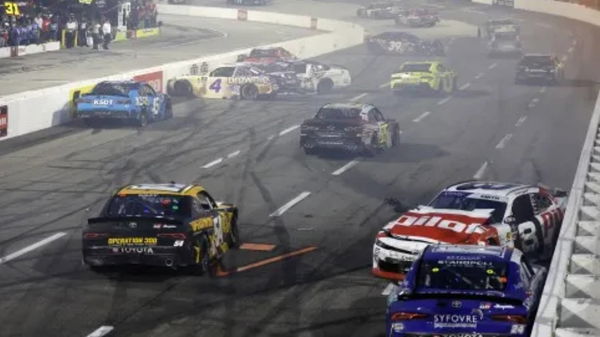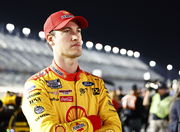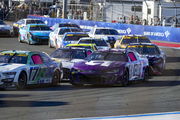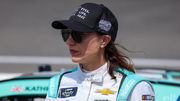

Three-time Cup Series champion and four-time Daytona 500 winner Cale Yarborough once said, “Driving a race car is like dancing with a chainsaw.” If Yarborough was watching the NASCAR Xfinity Series race at Martinsville, he might have reconsidered his analogy. A chainsaw at least has a predictable rhythm—Saturday’s race had none. Instead, it was chaos wrapped in metal, where wrecking replaced racing and desperation overshadowed skill.
The oldest NASCAR venue is supposed to be a proving ground, a half-mile paperclip where drivers earn respect and develop their craft. Instead, it has become a demolition derby where drivers treat fenders like battering rams. The 2025 Xfinity race was an embarrassment, with 14 cautions, a red flag, and an absurd 104 of 256 laps run under yellow. It means more than 40% of the race was spent crawling behind the pace car instead of competing.
The event wasn’t just chaotic—it was an embarrassment to the sport. And it also raised a big question: Should Martinsville ban rookies? The question isn’t just about rookies—it’s about whether Xfinity drivers, particularly the inexperienced ones, can handle Martinsville’s unique demands. The on-track disaster exposed serious issues with how Xfinity races unfold at short tracks. So, let’s break it down.
ADVERTISEMENT
Article continues below this ad
Identifying the Martinsville race problems!
The Martinsville race wasn’t just aggressive—it was reckless. Rookie Sammy Smith wrecked Taylor Gray for the lead on the final lap, triggering a massive pileup. Austin Hill, who was fifth at the time, slipped through the chaos to steal the win. Notably, Hill led for less than a quarter mile but still took the checkered flag and a $100,000 Dash 4 Cash bonus. But this wasn’t a display of racing talent. It was just about survival of the fittest.
Additionally, Smith’s post-race reaction only fueled the controversy. Smith defended his actions by saying, “That’s what you have to do.” That mindset is the problem. Winning at all costs has replaced actual racecraft, and NASCAR has let this behavior slide. Some might argue that Martinsville’s half-mile paperclip design encourages bumping, but that’s no excuse for what happened. Justin Allgaier, who finished third, said, “Using the bumper is one thing, but just completely wrecking people? That’s not racing.” The good thing is that the Cup race lived up to its billing and showed the Xfinity drivers how to race with respect and skill.
Just a day after Xfinity’s mayhem, Denny Hamlin won the Cup race cleanly with more than 4 seconds of the margin. Notably, Hamlin was one of those drivers who was frustrated with Saturday’s race. He had called it “Absolutely Garbage.” This reflects that young drivers have a different approach when it comes to competing in a race at a short track. They just see a win and a playoff spot in front of them. The win-and-in format encourages drivers to throw caution—and their competitors—out the window.
A replay of the #NASCAROvertime finish at @MartinsvilleSwy. pic.twitter.com/fGJecynkQT
— NASCAR Xfinity (@NASCAR_Xfinity) March 29, 2025
What’s your perspective on:
Is NASCAR's current system rewarding money over talent, leading to reckless racing at Martinsville?
Have an interesting take?
A win at any cost is often the easiest path to the postseason. Smith’s move on Gray wasn’t about racing smart; it was about the desperation of booking a spot in playoffs. NASCAR created this environment, and now it’s watching it spiral out of control. Another reason for such a situation is that many Xfinity drivers lack short-track experience. Unlike past generations, they haven’t climbed the ranks through local short tracks. Instead, many get rides because of financial backing, not talent.
Well, Jeb Burton was furious with Daniel Dye, whose father has a dealership network and he’s found a seat at Kaulig Racing. Burton was in contention for a top 10 finish, but Dye wrecked him, and he had to settle for a P11 finish. And he was fuming after the Martinsville race. “He’s just driving over his head with no respect, so I just came down here to tell him I didn’t appreciate it. If he wants to race like that, I’ll put him over the grandstands the next time we’re here.”
And just to keep it clean, it’s not that we are saying it randomly. NASCAR Cup series champion Joey Logano had openly called out this flawed system of pay drivers. “I have to pay to drive a Xfinity car or a Truck. I have to show up with money on the doorstep to drive one,” he said in an interview in 2024. This reflects how the lower NASCAR series works. Some of these drivers just buy a seat and start racing recklessly.
Additionally, these drivers don’t pay for the cars they wreck, so they race with no fear of consequences. Owners foot the repair bills, and as Brad Keselowski pointed out, until they start benching reckless drivers, nothing will change. Teams are afraid to sit a funded driver because they might lose sponsorship money. But if every team enforced discipline together, the culture could shift.
The biggest issue is that there are no real consequences for dirty driving. NASCAR’s hands-off approach lets drivers self-police, but when an entire field races without regard for each other, it leads to disaster. “These kids don’t respect their equipment, they don’t respect the guy next to them,” Kyle Petty said. That mentality turns races into destruction derbies instead of displays of talent.
Trending
How could NASCAR clean up the mess?
“(Saturday) was a joke, and all of those drivers should be ashamed of themselves. They don’t have a clue. Hopefully, they’ll figure it out. But if you want to stand (in victory lane on Sunday), you can’t act like they did,” Denny Hamlin’s former Crew chief Chris Gabehart said on Sunday. As it is hard to argue with him, what are the solutions that can help NASCAR to promote clean, skillful racing instead of this wreckfest.
ADVERTISEMENT
Article continues below this ad
Remember the question we asked in the beginning: Should Martinsville ban rookies? The answer is no. This will surely not help NASCAR in the long term. Instead of banning rookies, NASCAR should look into officiating their presence. One way to curb the mayhem is to require a short-track license before drivers can compete at tracks like Martinsville. If a driver hasn’t proven themselves in lower-tier short-track races, they shouldn’t be thrown into the deep end.
This would also force young drivers to learn respect and racecraft before competing on one of the toughest tracks in the country. Another change that could help? NASCAR should increase the number of races that Cup drivers are allowed in Xfinity or lower series. Incentivizing Cup veterans with five or more career wins to participate in Xfinity short-track races could help restore order. When rookies see how professionals handle short-track battles, they’ll learn that skill beats brute force.
The final piece of the puzzle is officiating. NASCAR needs real-time penalties for blatant wrecks. Right now, drivers know they can dump someone without major consequences. If race control issued immediate drive-through penalties for unnecessary contact—similar to how Formula 1 polices aggressive driving—it would force competitors to think twice before making a reckless move.
ADVERTISEMENT
Article continues below this ad
At the end of the day, Martinsville isn’t the problem—the way drivers approach it is. NASCAR needs to step in before Xfinity short-track racing becomes a complete embarrassment. Whether it’s banning rookies until they prove themselves, implementing an avoidable contact rule, or making teams financially accountable for wrecked cars, something has to change. In Dale Jr.’s words, “This racetrack is historic in the grand scheme of all things NASCAR and deserves better.” So, it’s high time now before NASCAR steps in to make some serious changes.
ADVERTISEMENT
ADVERTISEMENT
ADVERTISEMENT
ADVERTISEMENT







Is NASCAR's current system rewarding money over talent, leading to reckless racing at Martinsville?